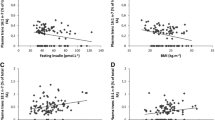Abstract
Diets rich in meat are claimed to contribute to the high tissue arachidonic acid (20∶4ω6) content in people in Westernized societies, but there are very few direct data to substantiate this assertion. Because meat contains a variety of long-chain polyunsaturated fatty acids (PUFA) that are susceptible to oxidation, we initially examined the effect of cooking on the long-chain PUFA content of beef, and then determined the effect of ingestion of lean beef on the concentration of long-chain PUFA in plasma phospholipids (PL). First, we examined the effect of grilling (5–15 min) and frying (10 min) different cuts of fat-trimmed lean beef on the long-chain PUFA content. Second, we investigated the effect of including 500 g lean beef daily (raw weight) for 4 wk on the fatty acid content and composition of plasma PL in 33 healthy volunteers. This study was part of a larger trial investigating the effect of lean beef on plasma cholesterol levels. In the first two weeks, the subjects ate a very low-fat diet (10% energy) followed by an increase in the dietary fat by 10% each week for the next 2 wk. The added fat consisted of beef fat, or olive oil (as the oil or a margarine) or safflower oil (as the oil or a margarine). This quantity of beef provided 60, 230, 125, 140 and 20 mg/d, respectively, of eicosatrienoic acid (20∶3ω6), 20∶4ω6, eicosapentaenoic acid (20∶5ω3), docosapentaenoic acid (22∶5ω3) and docosahexaenoic acid (22∶6ω3). Grilling for 10–15 min, but not frying, of the fat-trimmed lean beef resulted in 20–30% losses of the 20 and 22 carbon PUFA. The consumption of the lean beef during the first two-week period, when there was a very low level of dietary fat, was associated with significant increases in the proportion and concentration of 20∶3ω6, 20∶4ω6, 20∶5ω3 and 22∶5ω3 in the plasma PL and a significant decrease in the proportion and content of 18∶2ω6. The addition of beef fat or olive oil to the diets containing lean beef did not alter the plasma PL fatty acid profile compared with the very low-fat diet, whereas the addition of safflower oil maintained the significant increases in 20∶4ω6 and 22∶5ω3 but led to decreases in 18∶3ω3 and 20∶5ω3 compared with the very lowfat diet. The results showed that diets rich in lean beef increased the 20∶3ω6, 20∶4ω6 and the long-chain ω3 PUFA levels in the plasma PL. A high level of linoleic acid in diets rich in lean beef prevented the rise in the plasma level of 20∶3ω6 and 20∶5ω3, two fatty acids known to antagonize the effects of 20∶4ω6 on platelet aggregation.
Similar content being viewed by others
Abbreviations
- PGE1 :
-
prostaglandin E1
- PL:
-
phospholipids
- P/S:
-
polyunsaturated fatty acid/saturated fatty acid ratio
- PUFA:
-
polyunsaturated fatty acids
- TXA2 :
-
thromboxane A2
References
James, P., Norum, K., and Rosenberg, I. (1992)Nutr. Rev. 50, 68–70.
Budowski, P., and Crawford, M.A. (1985)Proc. Nutr. Soc. 44, 221–229.
Dolecek, T.A. (1992)Proc. Soc. Exp. Biol. Med. 200, 177–182.
Baghurst, K.I., Crawford, D.A., Worsley, D.A., and Record, S.J. (1988)Med. J. Aust. 149, 13–20.
Holman, R.T. (1964)Fed. Proc. 23, 1062–1067.
Sinclair, A.J., and O'Dea, K. (1990)Reducing Fat in Meat Animals (Wood, G. and Fisher, G., eds.) pp. 1–47, Elsevier Applied Science Publishers, New York.
Mohrhauer, H., and Holman, R.T. (1963)J. Lipid Res. 4, 151–159.
Sinclair, A.J. (1975)Lipids 10, 175–184.
Seyberth, H.W., Oetz, O., Kennedy, T., Sweetman, B.J., Danon, A., Frolich, J.C., Heimberg, M., and Oates, J.A. (1975)Clin. Pharmacol. Ther. 18, 521–529.
Sinclair, A.J., O'Dea, K., Dunstan, G., Ireland, P.D., and Niall, M. (1987)Lipids 22, 523–529.
Phinney, S.D., Odin, R.S., Johnson, S.B., and Holman, R.T. (1990)Am. J. Clin. Nutr. 51, 385–392.
Garg, A., Bonanome, A., Grundy, S.M., Zhang, Z.J., and Unger, R.H. (1988)N. Eng. J. Med. 319, 829–834.
Berner, L.A. (1993)J. Nutr. 123, 1175–1184.
Kinsella, J.E., Lokesh, B., and Stone, R.A. (1990)Am. J. Clin. Nutr. 52, 1–28.
O'Dea, K., Traianedes, K., Chisholm, K., Leyden, H., and Sinclair, A.J. (1990)Am. J. Clin. Nutr. 52, 491–494.
Morgan, S., O'Dea, K., and Sinclair, A.J. (1993)J. Am. Dietet. Assoc. 93, 644–648.
Sinclair, A.J., and O'Dea, K. (1987)Food Technol. Aust. 39, 228–231.
U.S. Department of Agriculture (1986)Composition of Foods. Agriculture Handbook, No. 8–13 U.S. Government Printing Office, Washington, D.C.
Marmer, W.N., Maxwell, R.J., and Williams, J.E. (1984)J. Anim. Sci. 59, 109–123.
Terrell, R.N., Suess, G.G., Cassens, R.G., and Bray R.W. (1968)J. Food Sci. 33, 562–565.
Anderson, D.B., Breedenstein, B.B., Kaufinan, R.G., Cassens, R.G., and Bray, R.W. (1971)J. Food Technol. 6, 141–152.
Janicki, L.J., and Appledorf, H. (1974)J. Food Sci. 39, 715–717.
Dratz, E.A., and Dees, A.J. (1986) inHealth Effects of Polyunsaturated Fatty Acids in Seafoods (Lands, W.E.M., ed.) pp. 319–351, Academic Press, New York.
Hodge, J., Sanders, K., and Sinclair, A.J. (1993)Lipids 28, 525–531.
Lasserre, M., Mendy, F., Spielman, D., and Jacotot, B. (1985)Lipids 20, 227–233.
Lands, W.E.M. (1991)Ann. Rev. Nutr. 11, 41–60.
Willis, A.L., and Smith, D.L. (1989) inNew Protective Roles for Selected Nutrients (Spiller, G.A., and Scala, J., eds.) pp. 40–108, Alan R. Liss, New York.
von Schacky, C., Fischer, S., and Weber, P.C. (1985)J. Clin. Invest. 76, 1626–1631.
Knapp, H.R., Reilly, I.A.G., Alessandrini, P. and FitzGerald, G.A. (1986)N. Engl. J. Med. 314, 937–942.
Holman, R.T., Johnson, S.B., and hatch, T.F. (1982)Am. J., Clin. Nutr. 35, 617–623.
Holman, R.T. (1993) inEssential Fatty Acids and Eicosanoids: Invited Papers from the Third International Congress (Sinclair, A.J., and Gibson, R.A., eds.) pp. 3–17, AOCS Press, Champaign.
Author information
Authors and Affiliations
About this article
Cite this article
Sinclair, A.J., Johnson, L., O'Dea, K. et al. Diets rich in lean beef increase arachidonic acid and long-chain ω3 polyunsaturated fatty acid levels in plasma phospholipids. Lipids 29, 337–343 (1994). https://doi.org/10.1007/BF02537187
Received:
Revised:
Accepted:
Issue Date:
DOI: https://doi.org/10.1007/BF02537187




